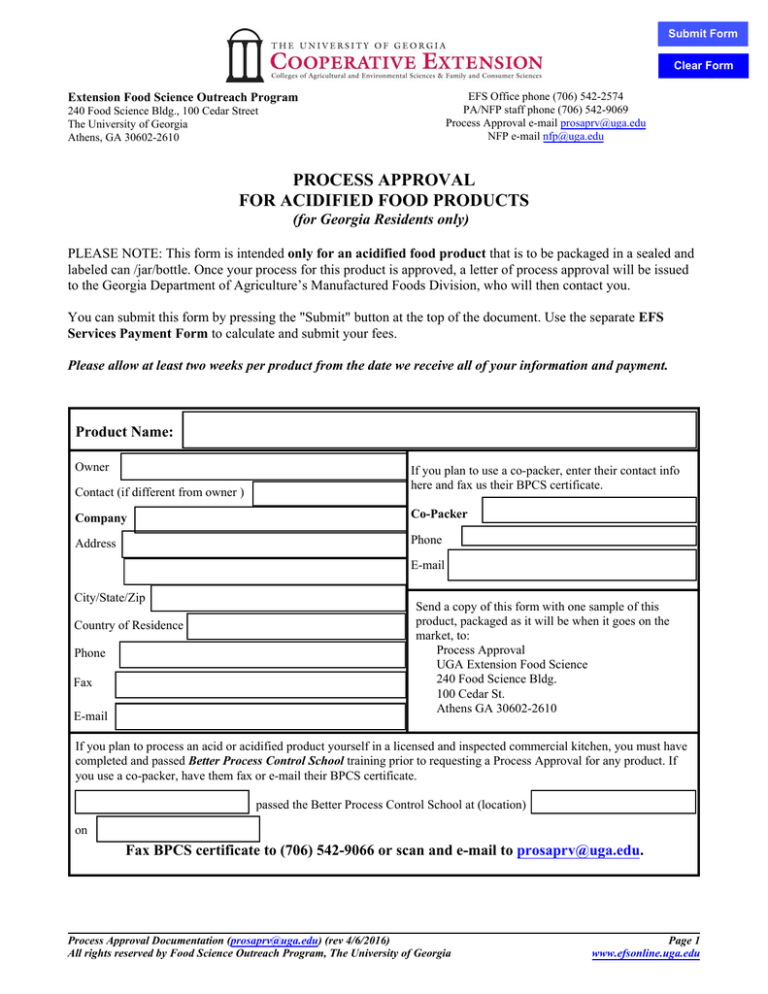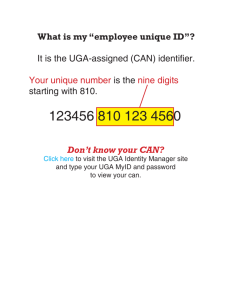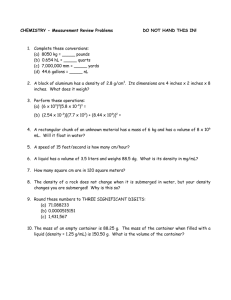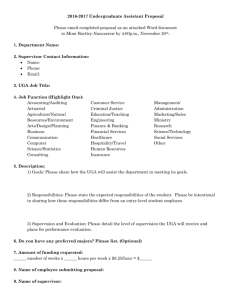
Submit Form
Clear Form
EFS Office phone (706) 542-2574
PA/NFP staff phone (706) 542-9069
Process Approval e-mail prosaprv@uga.edu
NFP e-mail nfp@uga.edu
Extension Food Science Outreach Program
240 Food Science Bldg., 100 Cedar Street
The University of Georgia
Athens, GA 30602-2610
PROCESS APPROVAL
FOR ACIDIFIED FOOD PRODUCTS
(for Georgia Residents only)
PLEASE NOTE: This form is intended only for an acidified food product that is to be packaged in a sealed and
labeled can /jar/bottle. Once your process for this product is approved, a letter of process approval will be issued
to the Georgia Department of Agriculture’s Manufactured Foods Division, who will then contact you.
You can submit this form by pressing the "Submit" button at the top of the document. Use the separate EFS
Services Payment Form to calculate and submit your fees.
Please allow at least two weeks per product from the date we receive all of your information and payment.
Product Name:
Owner
Contact (if different from owner )
If you plan to use a co-packer, enter their contact info
here and fax us their BPCS certificate.
Company
Co-Packer
Address
Phone
E-mail
City/State/Zip
Country of Residence
Phone
Fax
E-mail
Send a copy of this form with one sample of this
product, packaged as it will be when it goes on the
market, to:
Process Approval
UGA Extension Food Science
240 Food Science Bldg.
100 Cedar St.
Athens GA 30602-2610
If you plan to process an acid or acidified product yourself in a licensed and inspected commercial kitchen, you must have
completed and passed Better Process Control School training prior to requesting a Process Approval for any product. If
you use a co-packer, have them fax or e-mail their BPCS certificate.
passed the Better Process Control School at (location)
on
Fax BPCS certificate to (706) 542-9066 or scan and e-mail to prosaprv@uga.edu.
Process Approval Documentation (prosaprv@uga.edu) (rev 4/6/2016)
All rights reserved by Food Science Outreach Program, The University of Georgia
Page 1
www.efsonline.uga.edu
Process for
Company
PROCESSING INSTRUCTIONS for
Recipe/Formulation of Your Product – List all ingredients in your recipe for one batch of product, using
accurate measurements (i.e., grams, pounds, ounces, etc., not "pinch"!). Household measure is acceptable. If a
commercially prepared product (such as mustard or mayonnaise) is used in your recipe, please send the
ingredient label with your sample. If using an ingredient from a specific company, include company name and
full ingredient name in the blank. Indicate if only this brand will be used for your product. If a food additive (i.e.,
gum, preservative, etc.) is used, type the name of ingredient as given by your suppler.
Amount
Unit of Measure
Ingredient
Select one
Select one
Select one
Select one
Select one
Select one
Select one
Select one
Select one
Select one
Select one
Select one
Select one
Select one
Select one
Select one
Select one
Select one
Select one
Select one
Select one
Process Approval Documentation (prosaprv@uga.edu) (rev 4/6/2016)
All rights reserved by Food Science Outreach Program, The University of Georgia
Page 2
www.efsonline.uga.edu
Process for
Company
pH Testing Procedures
Instructions for preparing samples and taking pH measurements are given on the last page of this form.
Raw pH of Mixed Ingredients before adding acidifying agent:
(to nearest hundredth - e.g., 4.80)
pH of Acidifying agent(s) used in this product (to nearest hundredth - e.g., 3.25)*
* Pour a small amount of the acidifying agent (about ¼ cup) into a clean jar or cup and take pH with
calibrated pH meter and probe, to the nearest hundredth (two numbers after decimal). Do not measure in the
bottle. Enter pH in the box beside the acidifier(s) used in your recipe. Leave the other boxes blank.
Vinegar / Acetic Acid
Tomato
White Vinegar
Apple Cider Vinegar
Lime Juice
Lemon Juice
Other Acidifer (please type name and its pH below):
Method of acidification:
Batch
Direct
Indirect
Preservatives used (if any):
Maximum equilibrium pH of product (to nearest hundredth - e.g., 3.97)*:
* Open one container of product 24 hours after processing and packaging/sealing. Using a clean probe and
calibrated pH meter to take pH reading. DO NOT REFRIGERATE sample before taking pH!
Product Classification (to be completed by process authority)
Based on the recipe, product formulation, and the maximum equilibrium pH, this product has
been classified under 21 CFR 114 as:
Acid
Acidified
Low-Acid
Exempt
Reviewer’s Comments
Process Approval Documentation (prosaprv@uga.edu) (rev 4/6/2016)
All rights reserved by Food Science Outreach Program, The University of Georgia
Page 3
www.efsonline.uga.edu
Process for
Company
Containers & Closures *
Container 1 Type:
Check here if using more than one container size/shape.
Glass Bottle
Glass Jar
Metal/steel can
Aluminum can
Plastic (PET) Bottle
Flexible Pouch
Container not listed above - please give details below:
Container 1 Shape:
Round
Square
Rectangular
Irregular
Container 1 Dimensions (in inches only): *
Length
Width
Height
Thickness
Volume (fl. oz., to the
nearest whole number)
The FDA container dimension codes for Container 1 are:
See details of how the container dimension code is calculated in the box below
Length
Width
Container 2 Type:
Height
Glass Bottle
Glass Jar
Metal/steel can
Aluminum can
Thickness
Plastic (PET) Bottle
Flexible Pouch
Container not listed above - please give details below:
Container 2 Shape:
Round
Square
Rectangular
Irregular
Container 2 Dimensions (in inches only): *
Length
Width
Height
Thickness
Volume (fl. oz., to the
nearest whole number)
The FDA container dimension codes for Container 2 are:
See details of how the container dimension code is calculated in the box below
Length
Width
Height
Thickness
* FDA uses a two-part code for the dimensions of the container measured in inches. This information is
critical for completing your scheduled process filing on FDA form 2541a.
The first part of the code is the whole number of inches in the dimension. The second part represents
the fraction of inches in sixteenths.
For example:
1. If the dimension is a whole number in inches, create the code with that number and two zeros. 4 inches =
400
2. If the dimension is 5 15/16 inches, create the code from 5 and 15 = 515
3. If the dimension is 3 3/4 inches, convert the 3/4 inch to sixteenths (12/16), then create the code = 312
4. If the dimension is 4 and 1/8 inches, convert the 1/8 inches to sixteenths (2/16), then create the code from 4
and 2 = 402
Process Approval Documentation (prosaprv@uga.edu) (rev 4/6/2015)
All rights reserved by Food Science Outreach Program, The University of Georgia
Page 4
www.efsonline.uga.edu
Process for
Company
Closures/Caps to Be Used for this Product
One-piece screw-on lid with seal
Two-piece lid with seal and screw-on ring
Heat sealed foil with plastic cap
Tamper-evident safety seal
Other Closure(s) used - provide details below
Thermal Processing
Product Cooking/Heating (if applicable):
Equipment used for product cooking/heating:
Steam Jacketed Kettle
Pressure Cooker
Kettle/Pot
Manufacturer Name:
Model:
Heating Medium:
Temperature of Mixture Before Start of Cooking:
Maximum Cooking Temperature:
EF
EF
Measure at the
geometric center of
cooking vessel
Please give details of any special features on your thermal processing equipment (such as a mixer self-propelled, hand-held, or motorized external add-on, etc.):
Process Approval Documentation (prosaprv@uga.edu) (rev 4/6/2016)
All rights reserved by Food Science Outreach Program, The University of Georgia
Page 5
www.efsonline.uga.edu
Process for
Company
Method of Thermal Processing/Sterilizing Filled Containers
Hot Fill / Hold
Water Bath
(not pressurized)
Pressure Canner
(pressurized)
Retort
Packing Medium*:
* The packing medium is usually the liquid portion(s) of the product that is added over, or added to, the solid
portion(s) of the product. Examples of packing medium include: water, brine, sauces, and other liquid coverings.
If there is no liquid packing medium, enter "solid pack" as the packing medium.
Fill Temperature*:
EF
* Measure temperature (at geometric center of container) in the first filled container,
before capping. Rinse and dry the thermometer after recording the temperature. Minimum
recommended temperature is 180° F . If the product is not higher than 180° F, it should
be re-heated before filling containers for product safety.
Hold Temperature*:
EF
* Measure temperature (at geometric center of container) for the last filled container in
the same batch. The container must be sealed and a hole punched in the center of the lid to
insert the calibrated thermometer or probe.
Minimum recommended temperature is 180EF.
Finding the
geometric center
Time when thermometer is inserted into sealed container:
Time when internal temperature comes down to 180EF:
Hold Time* =
minutes
* Calculate HOLD TIME using the time when the thermometer was inserted through the lid into the last filled
container as the start time, and the time when the temperature of the contents comes down to 180E F as the end
time. If the temperature in the last container filled is NOT above 180E F at the start time, the product should be
re-heated for product safety.
I hereby acknowledge that all of the information provided in this form is accurate to the best of my knowledge.
I also acknowledge that if any information is missing or is not accurate as reported on this form, or if there is
any change from the stated information on this form (e.g., change in product recipe, processing procedure,
container size, etc.), I will notify UGA Food Science Extension as soon as I learn of these changes and request
a revision of the process approval.
___________________________________ (electronically signed)
Date _____________________
Owner/Processor Signature
Process Approval Documentation (prosaprv@uga.edu) (rev 4/6/2016)
All rights reserved by Food Science Outreach Program, The University of Georgia
Page 6
www.efsonline.uga.edu
Process for
Company
SCHEDULED PROCESS APPROVAL – FOR PROCESS AUTHORITY USE ONLY
To be calculated by the process authority
Least Sterilizing Value:
Not applicable
FO
IS Value
Least Sterilizing Value for this Process:
Start Temp (center)
EF
Processing Time
min.
Death Rate (z value)
EF
Ref. Temp.
EF
min.
pH of furnished sample
Least Sterilizing Value (FO)
(Attach EFS pH report to this record)
Comments from process authority:
DISCLAIMER: UGA Food Science Extension will not be held liable and/or responsible for any
missing or incorrectly reported information on the attached form.
This process (as given in the attached form) meets the requirements for processing an acidified product.
This approval is given based solely upon the information provided. If any changes are made to the
recipe or processing of this product by the manufacturer, this approval becomes null and void.
This process has been approved by
William C. Hurst, Ph.D. _____________________
Date ________________________
Anand Mohan, Ph.D. _____________________
Process Approval Documentation (prosaprv@uga.edu) (rev 4/6/2016)
All rights reserved by Food Science Outreach Program, The University of Georgia
Page 7
www.efsonline.uga.edu
Process for
Company
Appendix A: Instructions for performing pH testing
Equipment Needed: pH meter, electrode, piercing electrode (for whole ingredients like okra or cucumber), buffer
solutions 7.0 and 4.0, distilled water, lint-free drying cloths, #8 sieve
Instructions for measuring pH for liquid mixture (no solids):
1. Shake or stir product until all ingredients except the acidifier are mixed well.
2. Pour about ¼ cup into a clean jar or cup.
3. Measure pH with a calibrated pH meter and electrode. Take three separate readings. Be sure to clean the
electrode by rinsing well and blotting dry on a clean paper towel between each reading.
4. Record the raw pH readings below and on page 3 of the Process Approval form.
5. Rinse electrode with distilled water and blot dry on a clean paper towel before testing the sample again.
6. Take this measurement at three places in your sample and record them on this form.
Instructions for measuring pH for chopped or semi-liquid products:
1. Before you add the acidifier ingredient (vinegar, lemon or lime juice, etc.) to your recipe, measure put all of
your other ingredients in the recipe into your mixing bowl or kettle and stir together until well distributed.
2. Dip out about ½ cup of your mixture with as many of the low-acid ingredients in the sample as possible.
3. Drain off any liquid with a #8 sieve into a container.
4. Weigh and record the weight of the liquid and solid ingredients.
5. Put the drained sample into a clean blender bowl and blend until smooth.
6. Using a calibrated pH meter and clean electrode, stir the electrode around in the blended ingredients. Do not
allow the electrode to touch the bottom or sides of the bowl or cup.
7. Record the results below and on page 3 of the Process Approval form.
8. Rinse the electrode with distilled water and blot dry on a clean paper towel before testing the sample again.
9. Take this measurement at three different places in your product and record them on this form.
Instructions for measuring pH for whole ingredients (cucumbers, okra, etc.):
1. Wash and prepare whole ingredients to be used in this recipe.
2. Before placing them into a canning jar, insert a piercing pH electrode into center of the whole ingredient.
3. Record the results for this batch below and on page 3 of the Process Approval form.
4. Rinse the electrode with distilled water and blot dry on a clean paper towel before testing the sample again.
5. Take this measurement at three different places in your sample ingredients and record them on this form.
IMPORTANT: Prepare the raw ingredients before adding the acidifier as instructed above. Take three pH
readings with a calibrated pH meter, rinsing the probe and blotting it dry with a clean paper towel between
each reading. Record in the RAW pH column below.
Take three pH measurements at different levels of your sample 24 hours after processing. Calibrate your
pH meter each day before taking pH measurements (see instructions). Rinse pH electrode with distilled water
and dry with clean paper towel after taking each pH reading. Enter actual readings below (DO NOT
AVERAGE):
Product Name
Raw pH
(measure before acidification)
Lot Code:
Equilibrium pH
(24 hrs. after processing)
Internal pH of Solid Ingredients
(such as cucumber spears, okra, etc)
(24 hrs. after processing, use piercing electrode)
1.
2.
3.
Process Approval Documentation (prosaprv@uga.edu) (rev 4/6/2016)
All rights reserved by Food Science Outreach Program, The University of Georgia
Page 8
www.efsonline.uga.edu





